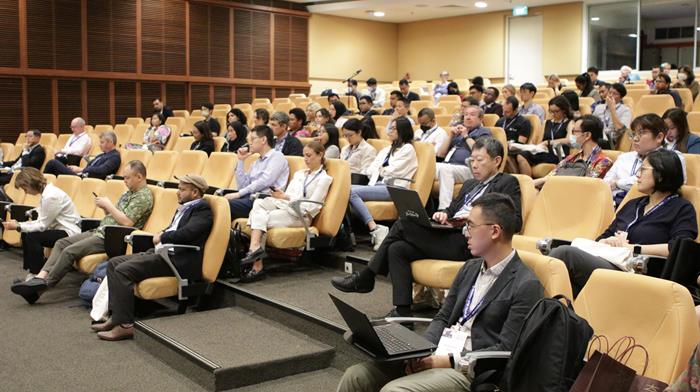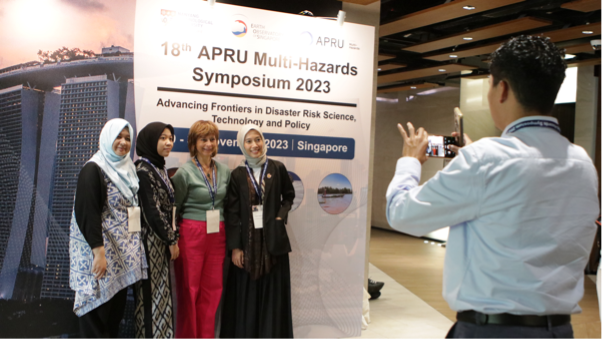A platform to learn, exchange ideas, and develop collaborations to reduce disaster risk and develop sustainable strategies that benefit all.
Earthquakes, volcanic eruptions, floods, droughts, extreme heat, and the compounding impacts of climate change are challenges that many countries around the world are facing first-hand. Many of these countries are located around the Pacific Rim, the area that borders the Pacific Ocean and extends from South America to New Zealand. Although there is no one-size fits-all solution, there is a lot countries can learn from each other to address some of these challenges and to develop strategies that reduce disaster risk faced by the communities and allow them to adapt to the impacts of climate change.
120 persons with a range of backgrounds and from more that 15 countries gathered to discuss these challenges and solutions during the 18th APRU Multi-Hazards Symposium, that the Earth Observatory of Singapore (EOS) at Nanyang Technological University, Singapore hosted on 29 and 30 November 2023, in collaboration with the Association of Pacific Rim Universities, a consortium of 61 universities around the Pacific Rim.
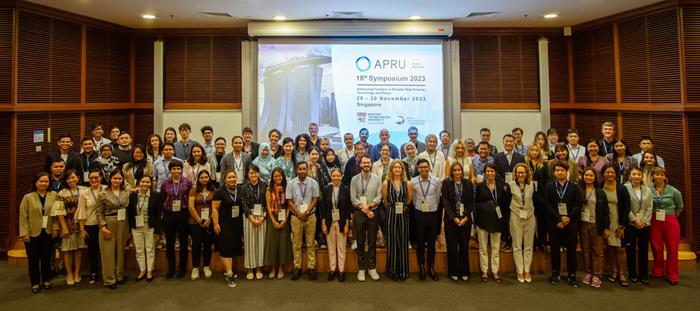
Participants to the 18th APRU Multi-Hazards Symposium 2023 (Source: Muhammad Hadi Ikhsan/Earth Observatory of Singapore)
Most participants were from Southeast Asia, where EOS has long-lasting collaborations, but scientists also came from Turkey, Poland, and even Mexico. “I am really interested in joining this symposium because I am from Turkey and our country is affected by many disasters especially earthquakes,” said Ms Ezgi Nizamoglu, a participant from Turkey. “By joining this symposium, it gave me the chance to see the other projects going on around the world about hazards and risk reduction. And it gave me the opportunity to meet other researchers to collaborate in the future,” she added. Ms Nizamoglu was one of the 29 recipients of the travel grants EOS was offering to early career researchers to join the event.
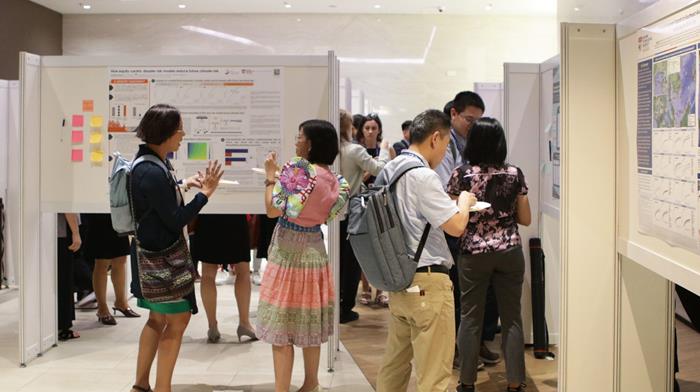
Participants to the symposium interacting with each other during one of the poster sessions (Source: Muhammad Hadi Ikhsan/Earth Observatory of Singapore)
The Symposium fostered discussions on the theme ‘Advancing Disaster Risk Science, Technology and Policy’. The first day was dedicated to hazards-related sessions about climate hazards, tectonics hazards, environmental hazards and public health. The second day focused on how to address disaster risk and promote resilience. Sessions encompassed topics related to finance and risk, socioecological resilience, and managing risk. “There is a lot of benefits that would come out of this event to help people build their networks, learn from each other, share lessons from around the world for things that have worked and things they tried that haven’t worked. I can really see the benefits of this event would last much longer than the event itself,” said Assistant Professor David Lallemant, a Principal Investigator (PI) at EOS, who co-chaired the event with Asst Prof Perrine Hamel and Prof Adam Switzer, also PIs at EOS.
Professor Takako Izumi, the Director of the APRU Multi-Hazards Program at Tohoku University, travelled to Singapore with a contingent of Japanese scientists bringing their unique perspectives on the topic. “The major objective of this symposium is that provide opportunity for networking among the participants, and share research results among colleagues, students and researchers in the region,” said Prof Izumi.

Key organisers and contributors to the Symposium. From left to right: David Lallemant, Pamela Cajilig, Adam Switzer, Perrine Hamel, Benjamin Horton, Takako Izumi, Peter Stones, Christina Schonleber, Olivia Jensen (Source: Muhammad Hadi Ikhsan/Earth Observatory of Singapore)
The symposium sessions were designed to promote discussions and help develop collaborations. Each session comprised a series of talks and roundtable discussions facilitated by the Symposium Scientific Committee to encourage deep engagement and inclusive conversations. “The main reason why I am interested in this multi-hazard symposium is to learn about the new science in this region and how we can discuss more about the policy that can reduce the risks,” said Dr Dhrubajyoti Samanta, a Senior Research Fellow at EOS who was part of the Scientific Committee.
The roundtable discussions fostered exchanges about a range of topics, from how to translate science findings into policies and integrate them with industrial applications, to how to communicate to different publics. Among the many takeaways, participants acknowledged that managing risk and addressing climate change involve diverse trade-offs. For example, how can we continue to develop our economies without polluting the air and affecting our health? Carbon neutrality seems to be key. Another trade-off that was discussed relates to the insurance sector: how to make it profitable while protecting the vulnerable populations? A second takeaway was about the need to include data about people and communities if we are to meaningfully reduce disaster risk. For example, documenting different experiences from localities on the ground can help capture the individual and collective experiences and learnings, to influence better policies. Risk is always changing, and we need a multi-disciplinary approach including the physical and social sciences to address it. Finally, it was suggested to use audience segmentation for more effective risk communication. Because in the end, what are science findings if we fail to communicate and reach the people?
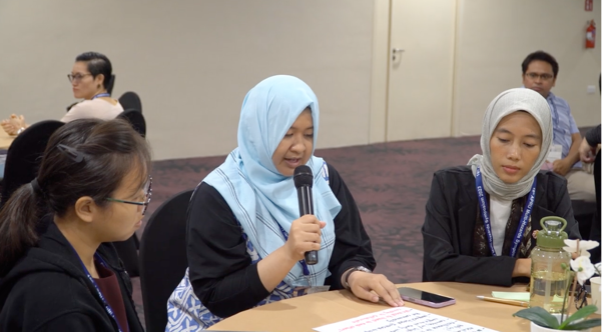 Participants were sharing their ideas during roundtable discussions. (Source: Kwok Kin Lee/Earth Observatory of Singapore)
Participants were sharing their ideas during roundtable discussions. (Source: Kwok Kin Lee/Earth Observatory of Singapore)
Ample time was also given for poster presentations to allow scientists to present and discuss their findings, and to get feedback from the community.
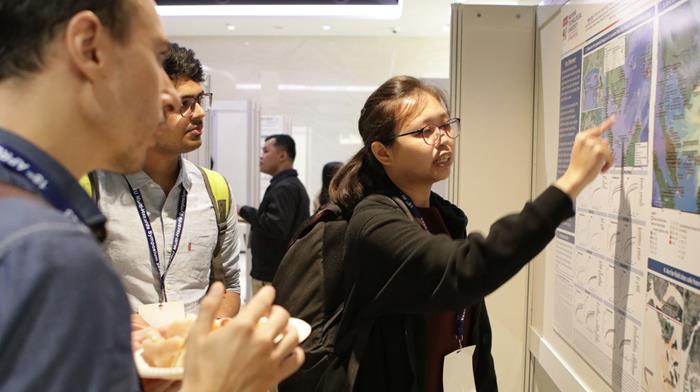 Participants interacting during one of the poster sessions (Source: Muhammad Hadi Ikhsan/Earth Observatory of Singapore)
Participants interacting during one of the poster sessions (Source: Muhammad Hadi Ikhsan/Earth Observatory of Singapore)
Three keynote speakers provided a range of perspectives to the symposium. Dr Pamela Cajilig, a Professorial Lecturer at the College of Architecture, the University of the Philippines and co-founder of Curiosity, underscored the need to learn from and with grassroots communities, including through stories, oral histories, and art forms, to reduce disaster risk. “This is a chance for participants to learn how we can minimize risks in the multi-hazard world in the multidisciplinary way, in a way that encourages reflection,” she said of the symposium.
The second keynote speaker, Mr Peter Stones, an Associate for Civil Water Resource and Infrastructure at ARUP, brought an engineering perspective to the event, and provided insights from projects undertaken in Southeast Asia to develop sustainable cities. For example, he presented ARUP’s work on the design of the new capital city of Indonesia, Nusantara.
Finally, the third keynote speaker, Dr Olivia Jensen, Deputy Director and Lead Scientist for Environment and Climate of the LRF Institute for the Public Understanding of Risk at the National University of Singapore, presented a thought-provoking talk about communicating risks, and how scientists can navigate the many factors that shape risk perception, such as feelings, biases and heuristics.
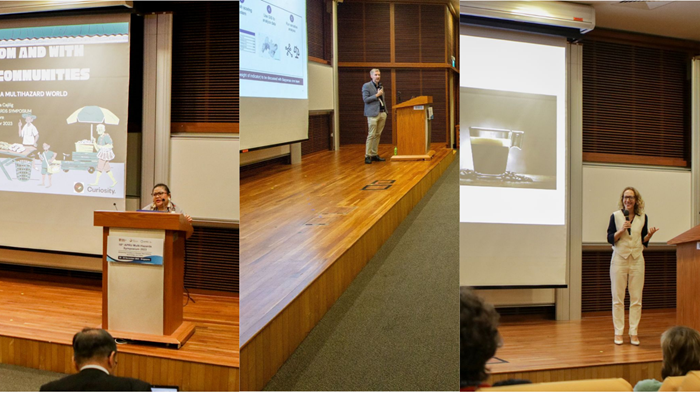 The three keynote speakers: Dr Pamela Cajilig, Mr Peter Stones, Dr Olivia Jensen (Source: Muhammad Hadi Ikhsan/Earth Observatory of Singapore)
The three keynote speakers: Dr Pamela Cajilig, Mr Peter Stones, Dr Olivia Jensen (Source: Muhammad Hadi Ikhsan/Earth Observatory of Singapore)
17 early career researchers competed in the symposium Lightning Talk competition, that provided a platform for each contestant to present their research in three minutes and with only one slide. The competition was judged by the event Chairs and Prof Izumi. Congratulations to the two winners Allan Tejada from the University of the Philippines Los Banos and SiddArtha Valle from the University of Batangas, Philippines. Congratulations also to the runner-ups Lorena Sabino from the University of the Philippines Los Banos, and Sreshtha Mondal from the National Institute of Advanced Studies, India.
 The winners, runner-ups and judges of the Lightning Talk Competition. From left to right: David Lallemant, Lorena Sabino, Adam Switzer, Sreshtha Mondal, Allan Tejada, SiddArtha Valle, Perrine Hamel, Takako Izumi (Source: Muhammad Hadi Ikhsan/Earth Observatory of Singapore)
The winners, runner-ups and judges of the Lightning Talk Competition. From left to right: David Lallemant, Lorena Sabino, Adam Switzer, Sreshtha Mondal, Allan Tejada, SiddArtha Valle, Perrine Hamel, Takako Izumi (Source: Muhammad Hadi Ikhsan/Earth Observatory of Singapore)
Through its format, inclusivity, diversity of perspectives, and engagements with early-career researchers, the Symposium provided a unique platform to promote resilience against natural hazards and climate change in the Pacific Rim. “What I hope that this meeting provides is a sense of hope – how we can become more resilient in a world that is in crisis,” said Professor Benjamin Horton, the Director of EOS.
The event concluded with a series of field trips to various locations in Singapore, to showcase EOS, NTU and Singapore’s sustainability efforts. Some participants visited various labs at EOS, as well as Gaia, the largest wooden building in Asia located at NTU. Others went on a nature walk in Sungei Buloh Wetland Reserve to observe mangroves and other natural features. The third group enjoyed a guided tour of the Augmented Reality installation ‘Adapting Waterfronts: Postcards from the Future, Singapore 2122’, while the fourth group went to Marina Barrage and for a visit of the Sustainable Singapore Gallery.

Some participants to the symposium visited Gaia, the largest wooden building in Asia, located at NTU (Source: Lauriane Chardot/Earth Observatory of Singapore)
For a brief overview of the Symposium, watch the video below.
Photo Gallery:
